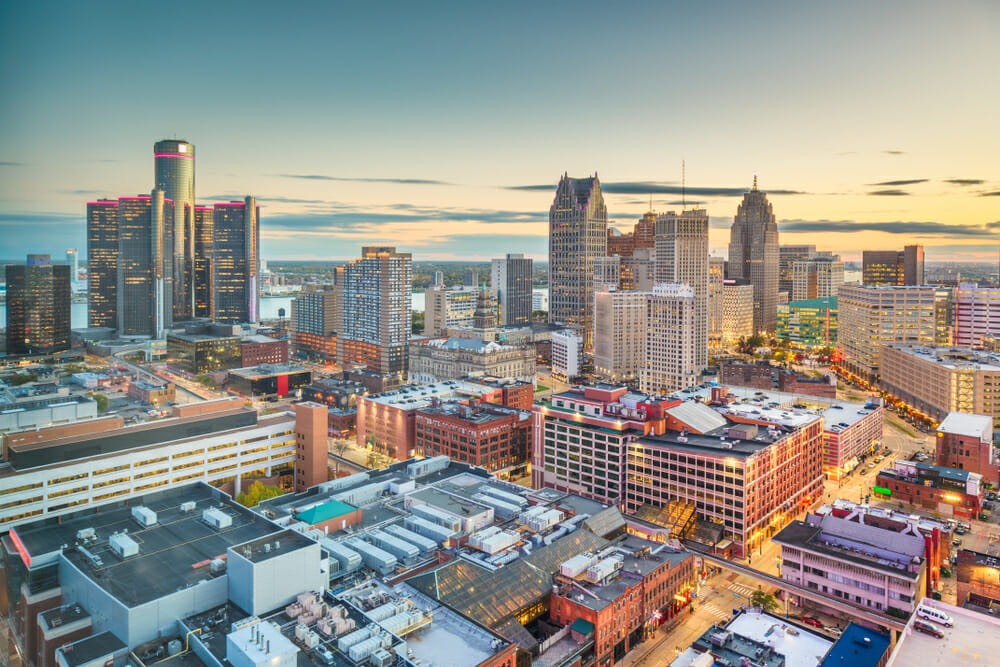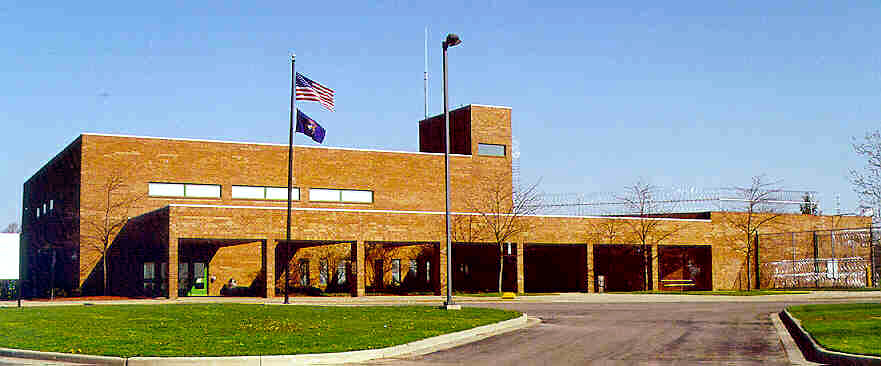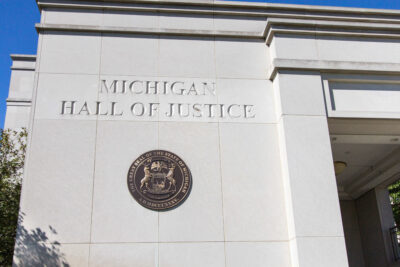
Criminal Rehabilitation and Justice in Michigan
Understanding criminal justice begins with analyzing the scope of incarceration in any given state. How many people are incarcerated in Michigan? What are the biggest prisons in Michigan? Answering these questions will provide one with insight into the rate of incarceration, and how involved the prison system is in the lives of everyday Michigan residents. According to the Bureau of Justice Assistance, Michigan has the 21st highest incarceration rate in the nation, behind West Virginia but ahead of Tennessee. Michigan incarcerates 337 of its residents for every 100,000 people living in the state, suggesting most Michigan residents know someone who is or has been incarcerated.1
According to the National Institute of Corrections, Michigan has 88 jails in 83 counties.2 Its jail population in 2019 was 17,020. Michigan also operates 20 prisons across the state, which hold an estimated 38,053 inmates per 2019 data. Michigan’s community corrections system has 142,653 people under probation and 13,488 under parole. The state operates all these institutions and departments with 11,941 employees and an annual budget of $2,019,056,200. According to the Urban Institute, the Department of Corrections is the seventh costliest item in the state’s annual budget, just behind police, highways, and roads.3

Image courtesy of www.michigan.gov
According to the Sentencing Project, Michigan no longer utilizes private prisons to incarcerate people. In the year 2000, Michigan had outsourced 449 inmates to private prisons. But by 2019, Michigan had ended its contracts with private prisons.4 There are, however, two federal prisons in Michigan. The Ionia Correctional Facility, located in Ionia, is the largest state prison in Michigan.5
Crime Rates in Michigan
One of the best ways to understand a state’s criminal justice system is to examine its crime. With that in mind, what is Michigan’s crime rate? According to the Michigan State Police Criminal Justice Information Center’s 2021 Crime in Michigan Annual Report, Michigan records about 437 violent crimes for every 100,000 people living in the state and about 1,585 property crimes for every 100,000.6
According to that same report, Michigan recorded 746 murders, 6,367 rapes, 4,016 robberies, 37,649 aggravated assaults, 21,466 burglaries, 93,733 larcenies, and 21,909 motor vehicle thefts in 2021. All of these figures except aggravated assaults and motor vehicle thefts reflected declining crime rates over figures from 2020.
A Look at Recidivism Rates in Michigan

Statistical data on recidivism in Michigan clearly shows the overall efficacy of Michigan’s criminal justice system. Thankfully, Michigan’s recidivism rate has been gradually declining, indicating the state is improving its incarceration modalities to make them more effective for inmates.
The most recent data shows Michigan’s recidivism rate is about 26%. To celebrate a recent decline in the recidivism rate, Department of Corrections Director Heidi Washington said, “Anytime there is a reduction in the recidivism rate it is a positive sign and shows the long and hard work our dedicated employees have done and continues to do is paying off. We remain focused on our goal of providing long-term public safety. This is a positive sign for the state and one everyone should take pride in it. I am grateful for the work of our amazing employees who are the reason why the MDOC stands as a national leader in the correctional field.” Ideally, MDOC will now invest resources in determining what incarceration modalities directly resulted in lowering recidivism.7
Criminal Reform in Michigan
The criminal justice system in Michigan is supposed to do more than incarcerate people who have broken the law. Criminal rehabilitation in Michigan involves efforts to help offenders overcome their criminal inclination. In 2021, Gov. Gretchen Whitmer signed Executive Order No. 2021-5, which created the Michigan Jail Reform Advisory Council. This program aims to assess and evaluate Michigan jails and carceral programs, seeking to improve conditions as much as possible to benefit inmates.8
Alternatives to Incarceration in Michigan

Alternatives to prison in Michigan should be made available, particularly for nonviolent offenders and offenders whose only crime is personal-use drug possession. Some such programs already exist, but Michigan’s Department of Corrections should expand them.
A sampling of alternatives to incarceration in Michigan include:
- Work release programs
- Deferred and delayed sentences
- Community service and volunteer hours
- Heightened fines and penalties for low-level infractions
- Inpatient and outpatient treatment for drug possession charges
- Probation or supervision for nonviolent offenses and re-offense cases
- Rehabilitation for mental, behavioral, or emotional issues that may have led to an offense
- House arrest and/or some form of electronic monitoring to ensure the individual is monitored but not incarcerated
State leadership should expand alternatives to incarceration in Michigan. They should also utilize educational programs inside prisons in Michigan to ensure offenders have a way to improve their knowledge and understanding of themselves, the world, how to safely and happily coexist with others, and how to be successful and fulfilled in life without committing a crime.
For those with underlying issues that led them to crime, rehabilitation programs inside prisons in Michigan should be utilized whenever possible to help offenders get better. The goal should be rehabilitation and improving the offender’s overall condition, not retribution and punishment for the individual’s crime.
Michigan has gotten some things right in how it’s modeled its criminal justice and incarceration system. But there are some areas where the state can make improvements. People who have loved ones in jail should advocate for more humane, results-based, and evidence-based rehabilitation programs for offenders.
Sources:
- BJS. “Prisoners in 2020 – Statistical Tables.” Bureau of Justice Statistics, 2020. bjs.ojp.gov
- NIC. “Michigan 2019.” National Institute of Corrections, 2019. nicic.gov
- Urban. “Project Michigan.” Urban Institute, 2022. urban.org
- SentencingProject. “Private Prisons in the United States.” The Sentencing Project, 2019. sentencingproject.org
- MDOC. “Ionia Correctional Facility (ICF).” Michigan Department of Corrections, 2022. michigan.gov
- MICR. “2021 Crime in Michigan Annual Report.” Michigan State Police Criminal Justice Information Center, 2022. michigan.gov
- MDOC. “Michigan’s Recidivism Rate.” Michigan Department of Corrections, 2022. michigan.gov
- MC. “Jail and Pretrial Reform.” Michigan Courts, 2021. courts.michigan.gov
Related Articles
Minnesota Just Became the 28th State to Abolish Life-Without-Parole Sentences for Children
In May of 2023, Minnesota became the latest state to abolish life-without-parole sentences for juvenile offenders, the 28th state to enact criminal justice reform laws...
Read more >>
Michigan’s Unique Approach to Solving Ongoing Criminal Justice Problems
According to the National Institute of Corrections, Michigan’s 2019 jail population was 17,020, and its prison population was 38,053.1 Michigan has the 21st-highest incarceration rate...
Read more >>
What Can We Do to Ensure the Formerly Incarcerated Do Not Return to Crime?
According to the Bureau of Justice Statistics, two out of three formerly incarcerated people in the U.S. commit another crime within three years of release....
Read more >>
I Finally Found Someone I Could Help
Conditions of Life Course Success The Conditions of Life Course made me go beyond the surface to find answers to questions using events in my...
Read more >>





